turn signal YAMAHA XMAX 250 2008 Owners Manual
[x] Cancel search | Manufacturer: YAMAHA, Model Year: 2008, Model line: XMAX 250, Model: YAMAHA XMAX 250 2008Pages: 88, PDF Size: 2.76 MB
Page 6 of 88
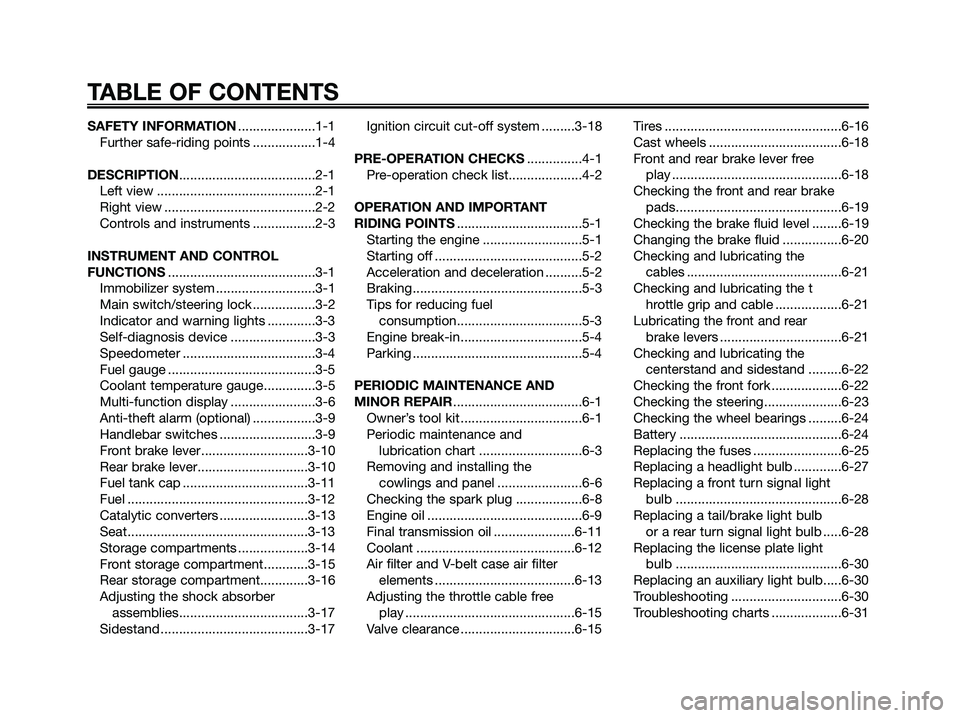
SAFETY INFORMATION.....................1-1
Further safe-riding points .................1-4
DESCRIPTION.....................................2-1
Left view ...........................................2-1
Right view .........................................2-2
Controls and instruments .................2-3
INSTRUMENT AND CONTROL
FUNCTIONS........................................3-1
Immobilizer system ...........................3-1
Main switch/steering lock .................3-2
Indicator and warning lights .............3-3
Self-diagnosis device .......................3-3
Speedometer ....................................3-4
Fuel gauge ........................................3-5
Coolant temperature gauge..............3-5
Multi-function display .......................3-6
Anti-theft alarm (optional) .................3-9
Handlebar switches ..........................3-9
Front brake lever.............................3-10
Rear brake lever..............................3-10
Fuel tank cap ..................................3-11
Fuel .................................................3-12
Catalytic converters ........................3-13
Seat.................................................3-13
Storage compartments ...................3-14
Front storage compartment............3-15
Rear storage compartment.............3-16
Adjusting the shock absorber
assemblies...................................3-17
Sidestand ........................................3-17Ignition circuit cut-off system .........3-18
PRE-OPERATION CHECKS...............4-1
Pre-operation check list....................4-2
OPERATION AND IMPORTANT
RIDING POINTS..................................5-1
Starting the engine ...........................5-1
Starting off ........................................5-2
Acceleration and deceleration ..........5-2
Braking..............................................5-3
Tips for reducing fuel
consumption..................................5-3
Engine break-in.................................5-4
Parking ..............................................5-4
PERIODIC MAINTENANCE AND
MINOR REPAIR...................................6-1
Owner’s tool kit .................................6-1
Periodic maintenance and
lubrication chart ............................6-3
Removing and installing the
cowlings and panel .......................6-6
Checking the spark plug ..................6-8
Engine oil ..........................................6-9
Final transmission oil ......................6-11
Coolant ...........................................6-12
Air filter and V-belt case air filter
elements ......................................6-13
Adjusting the throttle cable free
play ..............................................6-15
Valve clearance ...............................6-15Tires ................................................6-16
Cast wheels ....................................6-18
Front and rear brake lever free
play ..............................................6-18
Checking the front and rear brake
pads.............................................6-19
Checking the brake fluid level ........6-19
Changing the brake fluid ................6-20
Checking and lubricating the
cables ..........................................6-21
Checking and lubricating the t
hrottle grip and cable ..................6-21
Lubricating the front and rear
brake levers .................................6-21
Checking and lubricating the
centerstand and sidestand .........6-22
Checking the front fork ...................6-22
Checking the steering.....................6-23
Checking the wheel bearings .........6-24
Battery ............................................6-24
Replacing the fuses ........................6-25
Replacing a headlight bulb .............6-27
Replacing a front turn signal light
bulb .............................................6-28
Replacing a tail/brake light bulb
or a rear turn signal light bulb .....6-28
Replacing the license plate light
bulb .............................................6-30
Replacing an auxiliary light bulb.....6-30
Troubleshooting ..............................6-30
Troubleshooting charts ...................6-31
TABLE OF CONTENTS
1C0-F8199-E4.qxd 22/11/07 05:41 Página 6
Page 8 of 88
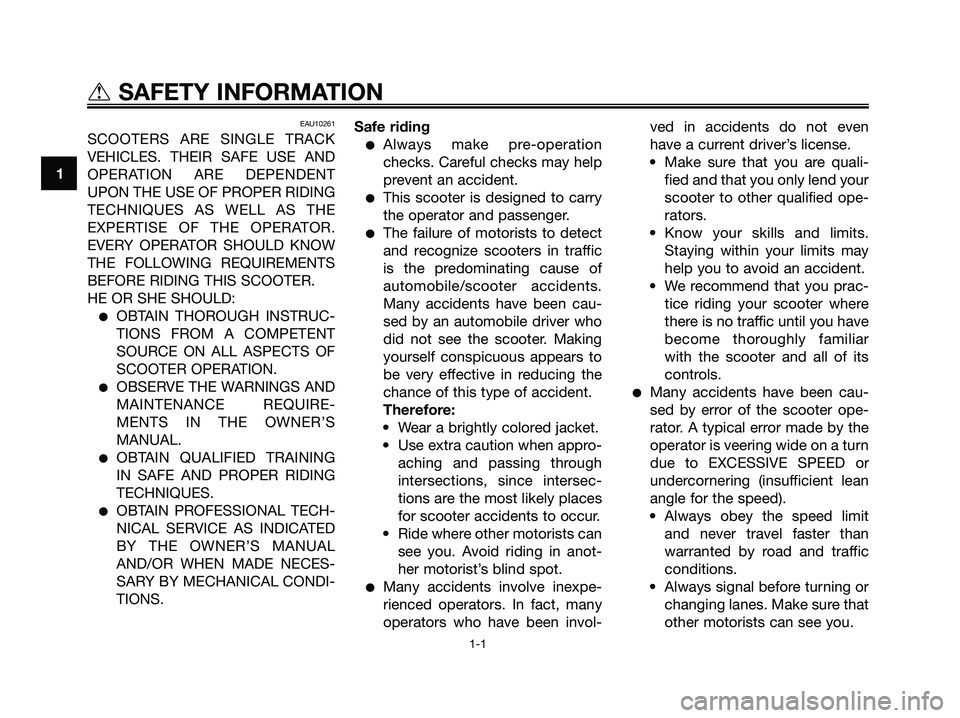
EAU10261
SCOOTERS ARE SINGLE TRACK
VEHICLES. THEIR SAFE USE AND
OPERATION ARE DEPENDENT
UPON THE USE OF PROPER RIDING
TECHNIQUES AS WELL AS THE
EXPERTISE OF THE OPERATOR.
EVERY OPERATOR SHOULD KNOW
THE FOLLOWING REQUIREMENTS
BEFORE RIDING THIS SCOOTER.
HE OR SHE SHOULD:
●OBTAIN THOROUGH INSTRUC-
TIONS FROM A COMPETENT
SOURCE ON ALL ASPECTS OF
SCOOTER OPERATION.
●OBSERVE THE WARNINGS AND
MAINTENANCE REQUIRE-
MENTS IN THE OWNER’S
MANUAL.
●OBTAIN QUALIFIED TRAINING
IN SAFE AND PROPER RIDING
TECHNIQUES.
●OBTAIN PROFESSIONAL TECH-
NICAL SERVICE AS INDICATED
BY THE OWNER’S MANUAL
AND/OR WHEN MADE NECES-
SARY BY MECHANICAL CONDI-
TIONS.Safe riding
●Always make pre-operation
checks. Careful checks may help
prevent an accident.
●This scooter is designed to carry
the operator and passenger.
●The failure of motorists to detect
and recognize scooters in traffic
is the predominating cause of
automobile/scooter accidents.
Many accidents have been cau-
sed by an automobile driver who
did not see the scooter. Making
yourself conspicuous appears to
be very effective in reducing the
chance of this type of accident.
Therefore:
• Wear a brightly colored jacket.
• Use extra caution when appro-
aching and passing through
intersections, since intersec-
tions are the most likely places
for scooter accidents to occur.
• Ride where other motorists can
see you. Avoid riding in anot-
her motorist’s blind spot.
●Many accidents involve inexpe-
rienced operators. In fact, many
operators who have been invol-ved in accidents do not even
have a current driver’s license.
• Make sure that you are quali-
fied and that you only lend your
scooter to other qualified ope-
rators.
• Know your skills and limits.
Staying within your limits may
help you to avoid an accident.
• We recommend that you prac-
tice riding your scooter where
there is no traffic until you have
become thoroughly familiar
with the scooter and all of its
controls.
●Many accidents have been cau-
sed by error of the scooter ope-
rator. A typical error made by the
operator is veering wide on a turn
due to EXCESSIVE SPEED or
undercornering (insufficient lean
angle for the speed).
• Always obey the speed limit
and never travel faster than
warranted by road and traffic
conditions.
• Always signal before turning or
changing lanes. Make sure that
other motorists can see you.
1
tSAFETY INFORMATION
1-1
1C0-F8199-E4.qxd 22/11/07 05:41 Página 8
Page 11 of 88
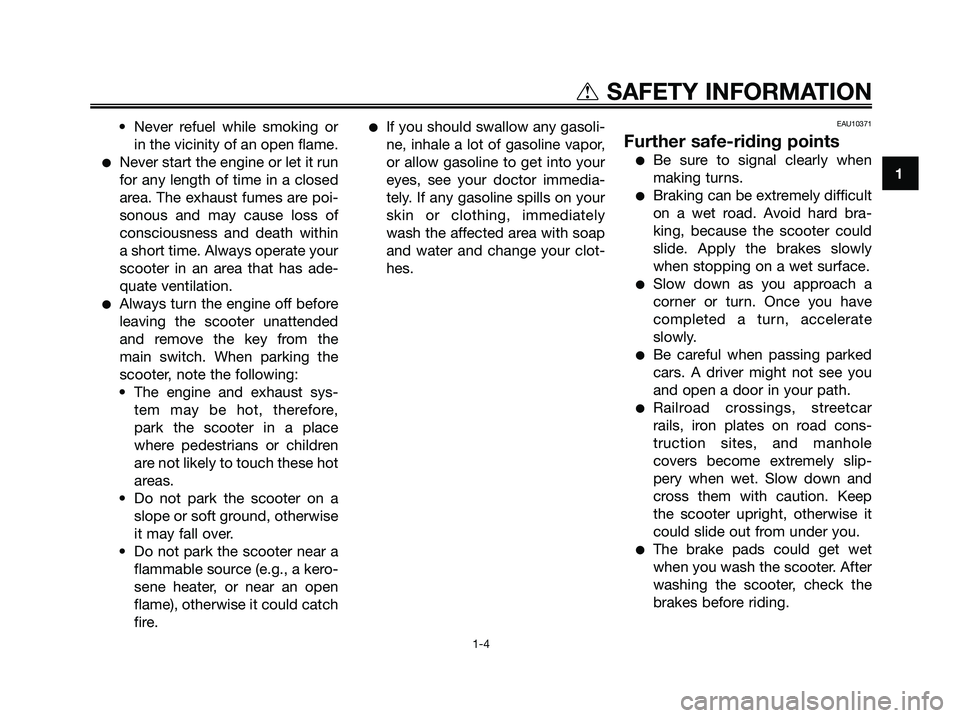
• Never refuel while smoking or
in the vicinity of an open flame.
●Never start the engine or let it run
for any length of time in a closed
area. The exhaust fumes are poi-
sonous and may cause loss of
consciousness and death within
a short time. Always operate your
scooter in an area that has ade-
quate ventilation.
●Always turn the engine off before
leaving the scooter unattended
and remove the key from the
main switch. When parking the
scooter, note the following:
• The engine and exhaust sys-
tem may be hot, therefore,
park the scooter in a place
where pedestrians or children
are not likely to touch these hot
areas.
• Do not park the scooter on a
slope or soft ground, otherwise
it may fall over.
• Do not park the scooter near a
flammable source (e.g., a kero-
sene heater, or near an open
flame), otherwise it could catch
fire.
●If you should swallow any gasoli-
ne, inhale a lot of gasoline vapor,
or allow gasoline to get into your
eyes, see your doctor immedia-
tely. If any gasoline spills on your
skin or clothing, immediately
wash the affected area with soap
and water and change your clot-
hes.EAU10371
Further safe-riding points
●Be sure to signal clearly when
making turns.
●Braking can be extremely difficult
on a wet road. Avoid hard bra-
king, because the scooter could
slide. Apply the brakes slowly
when stopping on a wet surface.
●Slow down as you approach a
corner or turn. Once you have
completed a turn, accelerate
slowly.
●Be careful when passing parked
cars. A driver might not see you
and open a door in your path.
●Railroad crossings, streetcar
rails, iron plates on road cons-
truction sites, and manhole
covers become extremely slip-
pery when wet. Slow down and
cross them with caution. Keep
the scooter upright, otherwise it
could slide out from under you.
●The brake pads could get wet
when you wash the scooter. After
washing the scooter, check the
brakes before riding.
1
tSAFETY INFORMATION
1-4
1C0-F8199-E4.qxd 22/11/07 05:41 Página 11
Page 18 of 88
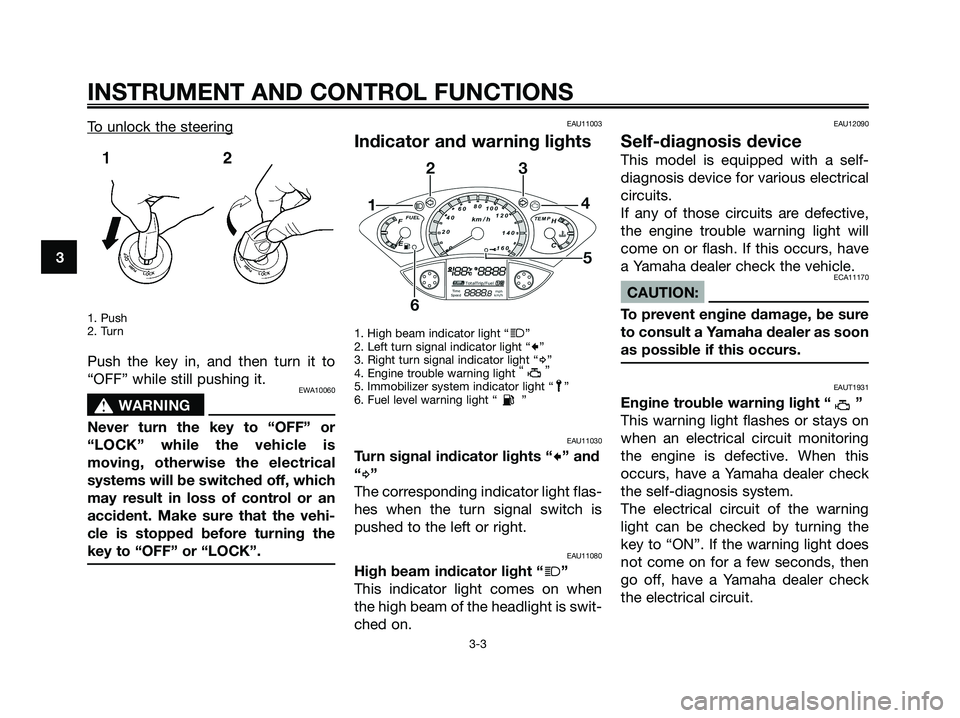
To unlock the steering
1. Push
2. Turn
Push the key in, and then turn it to
“OFF” while still pushing it.
EWA10060
s s
WARNING
Never turn the key to “OFF” or
“LOCK” while the vehicle is
moving, otherwise the electrical
systems will be switched off, which
may result in loss of control or an
accident. Make sure that the vehi-
cle is stopped before turning the
key to “OFF” or “LOCK”.
EAU11003
Indicator and warning lights
1. High beam indicator light “j”
2. Left turn signal indicator light “c”
3. Right turn signal indicator light “d”
4. Engine trouble warning light “”
5. Immobilizer system indicator light “ ”
6. Fuel level warning light “ ”
EAU11030
Turn signal indicator lights “c” and
“
d”
The corresponding indicator light flas-
hes when the turn signal switch is
pushed to the left or right.
EAU11080
High beam indicator light “j”
This indicator light comes on when
the high beam of the headlight is swit-
ched on.
EAU12090
Self-diagnosis device
This model is equipped with a self-
diagnosis device for various electrical
circuits.
If any of those circuits are defective,
the engine trouble warning light will
come on or flash. If this occurs, have
a Yamaha dealer check the vehicle.
ECA11170
CAUTION:
To prevent engine damage, be sure
to consult a Yamaha dealer as soon
as possible if this occurs.
EAUT1931
Engine trouble warning light “ ”
This warning light flashes or stays on
when an electrical circuit monitoring
the engine is defective. When this
occurs, have a Yamaha dealer check
the self-diagnosis system.
The electrical circuit of the warning
light can be checked by turning the
key to “ON”. If the warning light does
not come on for a few seconds, then
go off, have a Yamaha dealer check
the electrical circuit.
INSTRUMENT AND CONTROL FUNCTIONS
3-3
3
1C0-F8199-E4.qxd 22/11/07 05:41 Página 18
Page 24 of 88
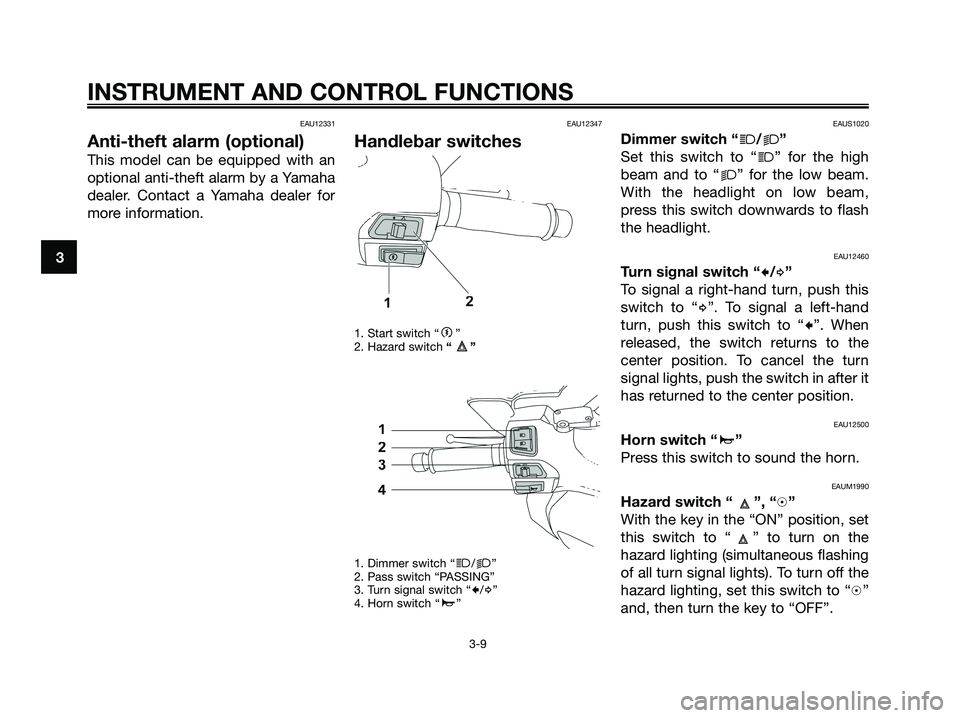
EAU12331
Anti-theft alarm (optional)
This model can be equipped with an
optional anti-theft alarm by a Yamaha
dealer. Contact a Yamaha dealer for
more information.
EAU12347
Handlebar switches
1. Start switch “g”
2. Hazard switch“”
1. Dimmer switch “
j/k”
2. Pass switch “PASSING”
3. Turn signal switch “
c/d”
4. Horn switch “a”
EAUS1020
Dimmer switch “j/k”
Set this switch to “
j” for the high
beam and to “
k” for the low beam.
With the headlight on low beam,
press this switch downwards to flash
the headlight.
EAU12460
Turn signal switch “c/d”
To signal a right-hand turn, push this
switch to “
d”. To signal a left-hand
turn, push this switch to “
c”. When
released, the switch returns to the
center position. To cancel the turn
signal lights, push the switch in after it
has returned to the center position.
EAU12500
Horn switch “a”
Press this switch to sound the horn.
EAUM1990
Hazard switch “ ”, “h”
With the key in the “ON” position, set
this switch to “ ” to turn on the
hazard lighting (simultaneous flashing
of all turn signal lights). To turn off the
hazard lighting, set this switch to “h”
and, then turn the key to “OFF”.
INSTRUMENT AND CONTROL FUNCTIONS
3-9
3
1C0-F8199-E4.qxd 22/11/07 05:41 Página 24
Page 39 of 88
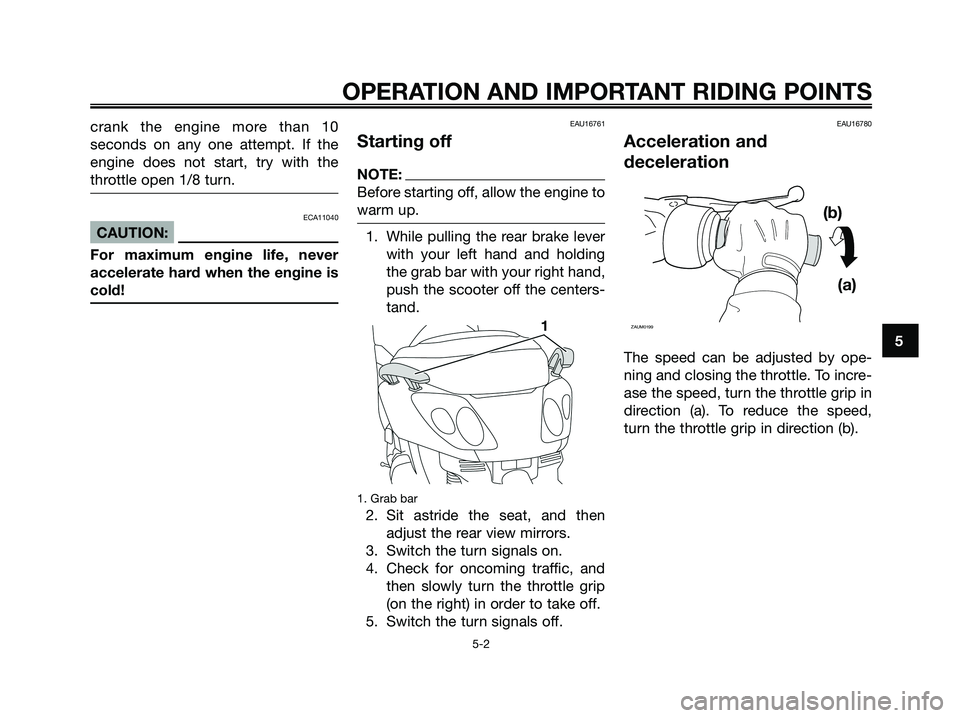
crank the engine more than 10
seconds on any one attempt. If the
engine does not start, try with the
throttle open 1/8 turn.
ECA11040
CAUTION:
For maximum engine life, never
accelerate hard when the engine is
cold!
EAU16761
Starting off
NOTE:
Before starting off, allow the engine to
warm up.
1. While pulling the rear brake lever
with your left hand and holding
the grab bar with your right hand,
push the scooter off the centers-
tand.
1. Grab bar
2. Sit astride the seat, and then
adjust the rear view mirrors.
3. Switch the turn signals on.
4. Check for oncoming traffic, and
then slowly turn the throttle grip
(on the right) in order to take off.
5. Switch the turn signals off.
EAU16780
Acceleration and
deceleration
The speed can be adjusted by ope-
ning and closing the throttle. To incre-
ase the speed, turn the throttle grip in
direction (a). To reduce the speed,
turn the throttle grip in direction (b).
(b)
(a)
ZAUM0199
OPERATION AND IMPORTANT RIDING POINTS
5-2
5
1C0-F8199-E4.qxd 22/11/07 05:41 Página 39
Page 47 of 88
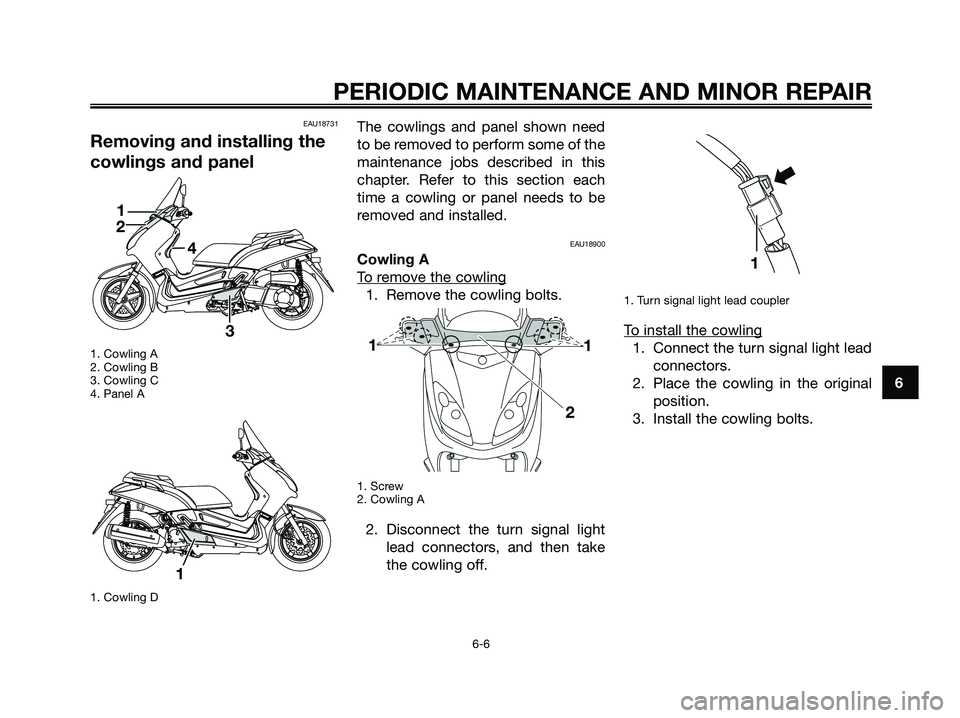
EAU18731
Removing and installing the
cowlings and panel
1. Cowling A
2. Cowling B
3. Cowling C
4. Panel A
1. Cowling D
The cowlings and panel shown need
to be removed to perform some of the
maintenance jobs described in this
chapter. Refer to this section each
time a cowling or panel needs to be
removed and installed.
EAU18900
Cowling A
T
o remove the cowling
1. Remove the cowling bolts.
1. Screw
2. Cowling A
2. Disconnect the turn signal light
lead connectors, and then take
the cowling off.
1. Turn signal light lead coupler
To install the cowling
1. Connect the turn signal light lead
connectors.
2. Place the cowling in the original
position.
3. Install the cowling bolts.
1
1
1
2
4
3
PERIODIC MAINTENANCE AND MINOR REPAIR
6-6
6
1C0-F8199-E4.qxd 22/11/07 05:41 Página 47
Page 67 of 88
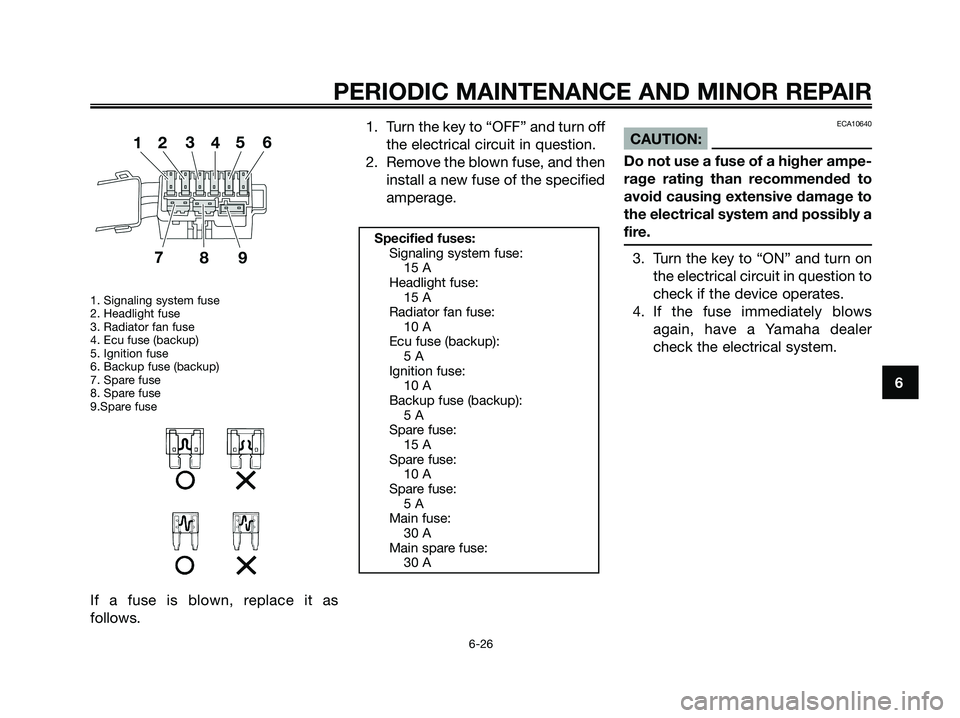
1. Signaling system fuse
2. Headlight fuse
3. Radiator fan fuse
4. Ecu fuse (backup)
5. Ignition fuse
6. Backup fuse (backup)
7. Spare fuse
8. Spare fuse
9.Spare fuse
If a fuse is blown, replace it as
follows.1. Turn the key to “OFF” and turn off
the electrical circuit in question.
2. Remove the blown fuse, and then
install a new fuse of the specified
amperage.
ECA10640
CAUTION:
Do not use a fuse of a higher ampe-
rage rating than recommended to
avoid causing extensive damage to
the electrical system and possibly a
fire.
3. Turn the key to “ON” and turn on
the electrical circuit in question to
check if the device operates.
4. If the fuse immediately blows
again, have a Yamaha dealer
check the electrical system.
Specified fuses:
Signaling system fuse:
15 A
Headlight fuse:
15 A
Radiator fan fuse:
10 A
Ecu fuse (backup):
5 A
Ignition fuse:
10 A
Backup fuse (backup):
5 A
Spare fuse:
15 A
Spare fuse:
10 A
Spare fuse:
5 A
Main fuse:
30 A
Main spare fuse:
30 A
PERIODIC MAINTENANCE AND MINOR REPAIR
6-26
6
1C0-F8199-E4.qxd 22/11/07 05:41 Página 67
Page 69 of 88
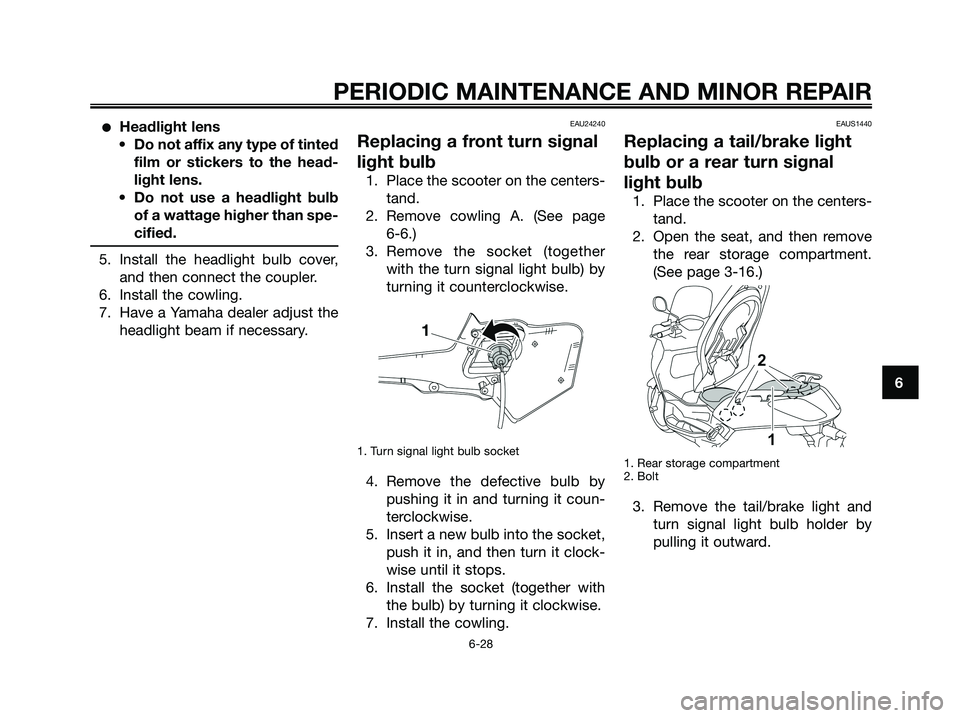
●Headlight lens
• Do not affix any type of tinted
film or stickers to the head-
light lens.
• Do not use a headlight bulb
of a wattage higher than spe-
cified.
5. Install the headlight bulb cover,
and then connect the coupler.
6. Install the cowling.
7. Have a Yamaha dealer adjust the
headlight beam if necessary.
EAU24240
Replacing a front turn signal
light bulb
1. Place the scooter on the centers-
tand.
2. Remove cowling A. (See page
6-6.)
3. Remove the socket (together
with the turn signal light bulb) by
turning it counterclockwise.
1. Turn signal light bulb socket
4. Remove the defective bulb by
pushing it in and turning it coun-
terclockwise.
5. Insert a new bulb into the socket,
push it in, and then turn it clock-
wise until it stops.
6. Install the socket (together with
the bulb) by turning it clockwise.
7. Install the cowling.
EAUS1440
Replacing a tail/brake light
bulb or a rear turn signal
light bulb
1. Place the scooter on the centers-
tand.
2. Open the seat, and then remove
the rear storage compartment.
(See page 3-16.)
1. Rear storage compartment
2. Bolt
3. Remove the tail/brake light and
turn signal light bulb holder by
pulling it outward.
PERIODIC MAINTENANCE AND MINOR REPAIR
6-28
6
1C0-F8199-E4.qxd 22/11/07 05:41 Página 69
Page 70 of 88
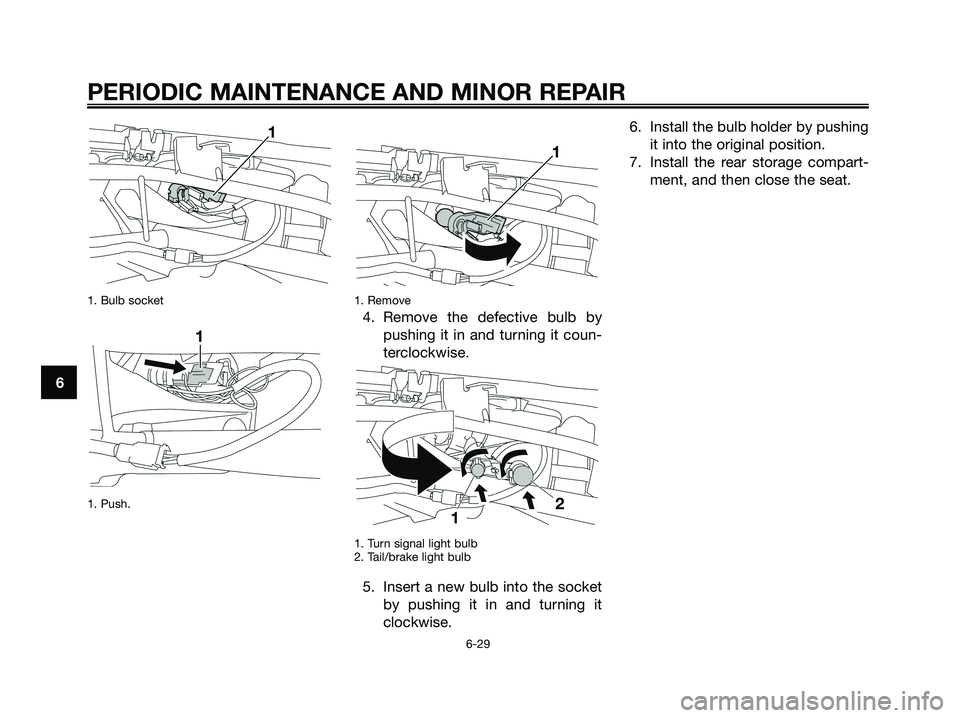
1. Bulb socket
1. Push.1. Remove
4. Remove the defective bulb by
pushing it in and turning it coun-
terclockwise.
1. Turn signal light bulb
2. Tail/brake light bulb
5. Insert a new bulb into the socket
by pushing it in and turning it
clockwise.6. Install the bulb holder by pushing
it into the original position.
7. Install the rear storage compart-
ment, and then close the seat.
PERIODIC MAINTENANCE AND MINOR REPAIR
6-29
6
1C0-F8199-E4.qxd 22/11/07 05:41 Página 70